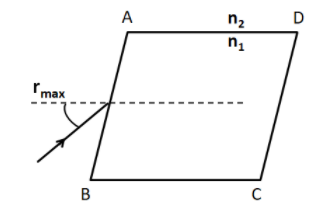
A rectangular glass slab ABCD of refractive index

(A)
(B)
(C)
(D)
Answer
143.1k+ views
Hint: To solve this question, we need to apply the concept of total internal reflection within the glass slab. Then applying the Snell’s law at the interface AB we will get the answer.
Complete step-by-step solution:
For emerging out of the face CD of the slab, the angle of incidence should be such that the refracted ray suffers total internal reflection within the rectangular slab. As it will suffer multiple total internal reflections within the slab, it will reach the face CD and get refracted out of the slab.
We know that for total internal reflection to occur, the light ray must be incident at an angle greater or equal to the critical angle of incidence.
For the maximum angle
Consider the following figure
In the triangle FED we have
Applying Snell’s law at the interface AB, we have
Putting (1) in above equation, we get
Now, we know that the critical angle of incidence is equal to the sine inverse of the reciprocal of the refractive index of denser medium with respect to the rarer medium. So we have
Putting (3) in (2) we get
Taking sine inverse both the sides, we get
Hence, the correct answer is option A.
Note: The phenomena of total internal reflection to get the light ray, which was incident on one face, transmitted to the opposite face is used in the optical fibre cables. The angle of incidence, which was
Complete step-by-step solution:
For emerging out of the face CD of the slab, the angle of incidence should be such that the refracted ray suffers total internal reflection within the rectangular slab. As it will suffer multiple total internal reflections within the slab, it will reach the face CD and get refracted out of the slab.
We know that for total internal reflection to occur, the light ray must be incident at an angle greater or equal to the critical angle of incidence.
For the maximum angle
Consider the following figure
In the triangle FED we have
Applying Snell’s law at the interface AB, we have
Putting (1) in above equation, we get
Now, we know that the critical angle of incidence is equal to the sine inverse of the reciprocal of the refractive index of denser medium with respect to the rarer medium. So we have
Putting (3) in (2) we get
Taking sine inverse both the sides, we get
Hence, the correct answer is option A.
Note: The phenomena of total internal reflection to get the light ray, which was incident on one face, transmitted to the opposite face is used in the optical fibre cables. The angle of incidence, which was
Recently Updated Pages
How to find Oxidation Number - Important Concepts for JEE

How Electromagnetic Waves are Formed - Important Concepts for JEE

Electrical Resistance - Important Concepts and Tips for JEE

Average Atomic Mass - Important Concepts and Tips for JEE

Chemical Equation - Important Concepts and Tips for JEE

Concept of CP and CV of Gas - Important Concepts and Tips for JEE

Trending doubts
JEE Main 2025 Session 2: Application Form (Out), Exam Dates (Released), Eligibility, & More

JEE Main Exam Marking Scheme: Detailed Breakdown of Marks and Negative Marking

JEE Main 2025: Derivation of Equation of Trajectory in Physics

Electric Field Due to Uniformly Charged Ring for JEE Main 2025 - Formula and Derivation

Electric field due to uniformly charged sphere class 12 physics JEE_Main

Degree of Dissociation and Its Formula With Solved Example for JEE

Other Pages
JEE Advanced Marks vs Ranks 2025: Understanding Category-wise Qualifying Marks and Previous Year Cut-offs

JEE Advanced 2025: Dates, Registration, Syllabus, Eligibility Criteria and More

JEE Advanced Weightage 2025 Chapter-Wise for Physics, Maths and Chemistry

Physics Average Value and RMS Value JEE Main 2025

Dual Nature of Radiation and Matter Class 12 Notes: CBSE Physics Chapter 11

Formula for number of images formed by two plane mirrors class 12 physics JEE_Main




